Import custom audiences
Custom audiences are a list of customers from your CRM. These lists of customers can be segmented in any way that you see fit. For example, all of your customers, customers that have transacted in the last 12 months, or customers that have unsubscribed.
What can I use custom audiences for?
You can use custom audiences on the Rokt network for two primary purposes:
- Excluding existing customers from seeing your offer on the Rokt marketplace (particularly useful if your campaign objective is acquisition).
- Targeting your existing customers with a Rokt campaign.
You can use the Custom Audience API to send Rokt your custom audience details at any time. Learn more about setting up the Custom Audience API here.
Inclusion List Restrictions
When using inclusion targeting lists to target existing customers, you should not include a list of fewer than 1,000 individuals. This protects user privacy by reducing the risk of hyper-targeted messaging.
Next steps
Before your audience goes live, you need to build a new creative and link your audience to a creative.
Importing custom audiences
You can import custom audiences in the following ways:
- Import via CSV
- Import via file transfer
- Import via Web SDK
- Import via LiveRamp
- Import via mParticle
- Import via Segment
Import via CSV
Selling to current customers is easier than looking for new ones; Rokt helps you strengthen your existing relationships using custom audiences.
Or, perhaps you want to make sure that your campaigns are not shown to existing customers. Rokt can use your data to identify new and existing customers who come through our platform.
If you have a customer list or data from your site, such as purchaser email addresses or ZIP code, you’re ready to get started.
Email lists
Rokt offers several ways to add existing customers to a Rokt list. You can import your customers from a CSV file to a new or existing list for the purpose of targeting or suppressing known customers.
Before you begin
- To import existing customers, you must know their email addresses, as this is the only field Rokt uses to identify unique individuals on the network.
- Email addresses can be imported in their raw format (e.g.,
john@rokt.com), or in a hashed format. Note that Rokt only supports SHA-256 hashing algorithms. - For files to be imported, your file should only contain email addresses (and in the first column, if applicable). Your file may or may not include a header.
- Your account can support multiple lists. When you upload a file, you need to decide if you are creating a new list or editing an existing list. When editing an existing list, you need to decide if all customers in the file upload should be added or removed from an existing list.
- When adding customers to an existing list, if a customer already exists in the list, that customer is ignored (i.e., the customer is not entered twice onto a list).
- When removing customers from an existing list, if a customer cannot be found, that customer is ignored.
Limits
| Type | Limit |
|---|---|
| File size | 200MB CSV file. |
Creating a list from CSV files
-
In the left navigation bar, go to Campaigns > Custom Audiences.

-
Click New custom audience in the top right corner of the page.
-
Select Email Customer List as the Audience Source.
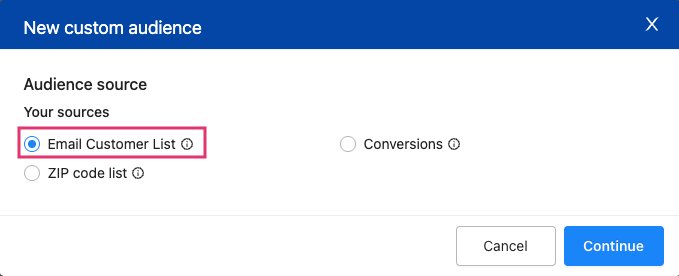
-
Enter a name for your custom audience. Click Upload to import a CSV file from your computer.
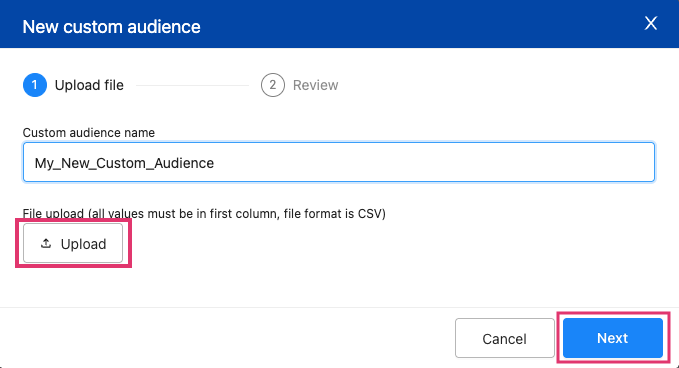
-
Once you have successfully uploaded your file click Next.
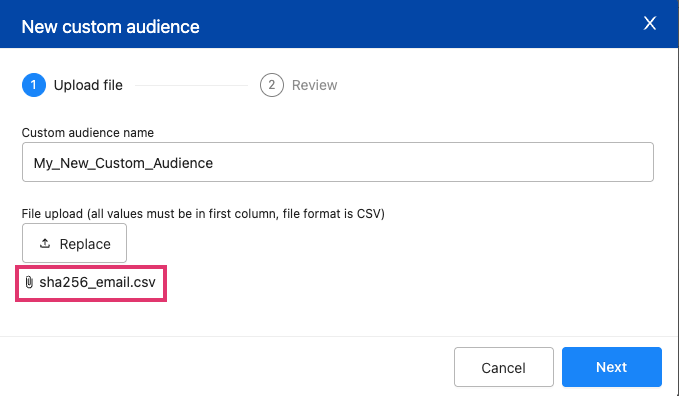
-
Review your upload details and click Save.
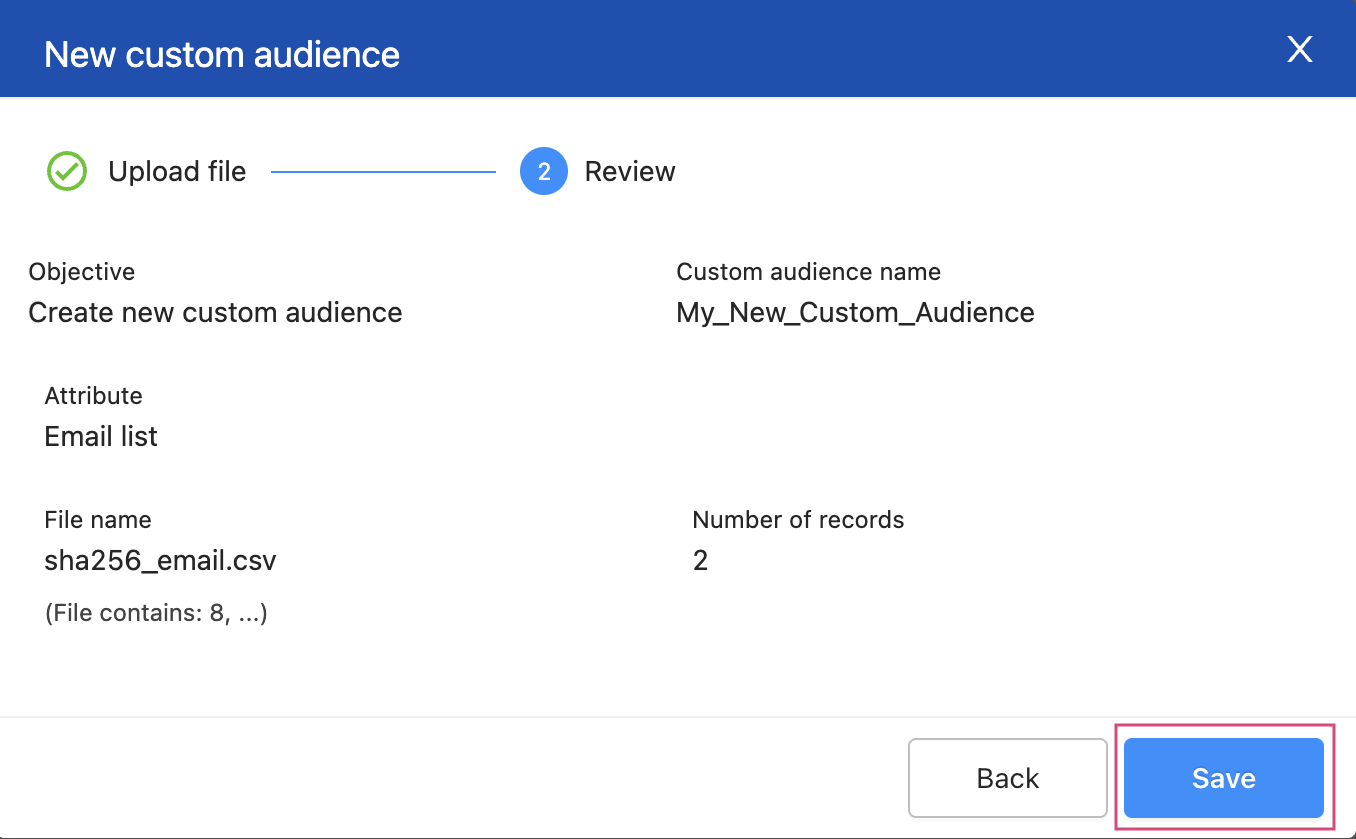
Your import task will start processing. You can navigate away from the page or even start another import task.
Multiple imports are queued one after the other so that there are not any clashes if the same email address is found in multiple files. Once an import task has completed, the next starts automatically.
Once your import is completed, it is listed with the following information: date, file name, and contacts added/removed. An email notification will be sent out upon completion.
You can target or suppress these email addresses in your audience settings for each of your campaigns. If you are already targeting the list you have added emails to, you don't need to change your targeting options.
Adding a custom audience to your campaign
- Selecting Include results in only showing your offer to customers within the selected custom audience.
- Selecting 'Exclude' will result in only showing your offer to users outside the selected custom audience.
-
From the left navigation, go to Campaigns.
-
Choose the campaign you want to apply your custom audience to.
-
Click Add Audience.
-
Name your audience and enter any other relevant demographic details.
-
Click Yes on the Email list setting.

-
Select the custom audience that you would like to target or exclude.
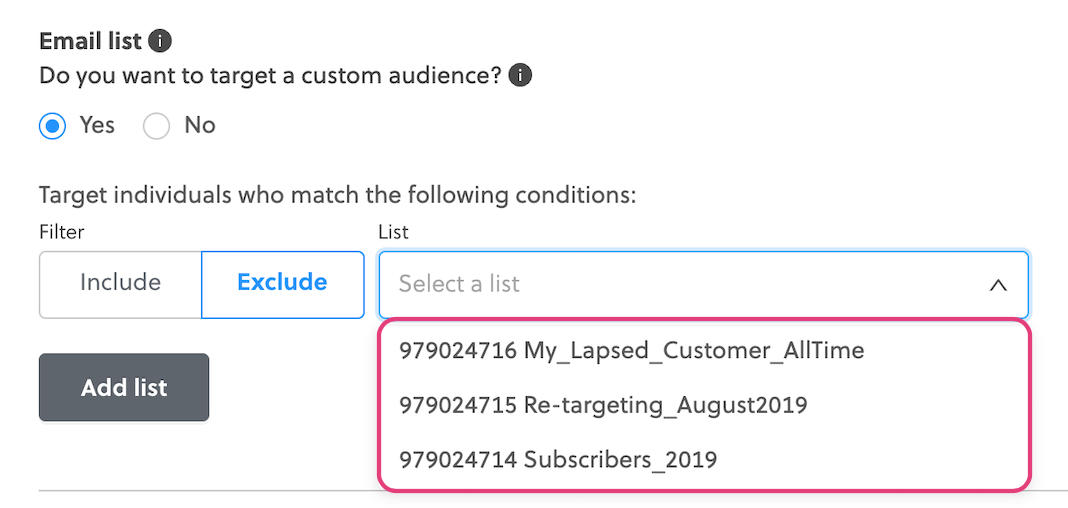 note
noteThe default name for your custom audience might appear as Advertiser Database.
-
Continue the configuration as you would any other audience.
ZIP code lists
Your business may only be able to target specific ZIP codes, for example due to delivery areas. Rokt allows you to target geographies with our locality targeting, however, setting up geographic targeting across all your audiences can be cumbersome. Instead, you can upload a list of ZIP codes that you would like to target and have this list available across all your audiences.
Before you begin
- You have a list of ZIP codes ready to go
- Files are in CSV format
- All ZIP codes must be in the first column
- No header should be present
- ZIP code must match the format expected for target country (e.g., five digits for U.S. ZIP codes)
Create a list from a CSV file
-
In the left navigation, click Campaigns, then Custom Audiences.

-
Click New custom audience in the top right corner of the page.
-
Select Zip code List as the Audience Source.
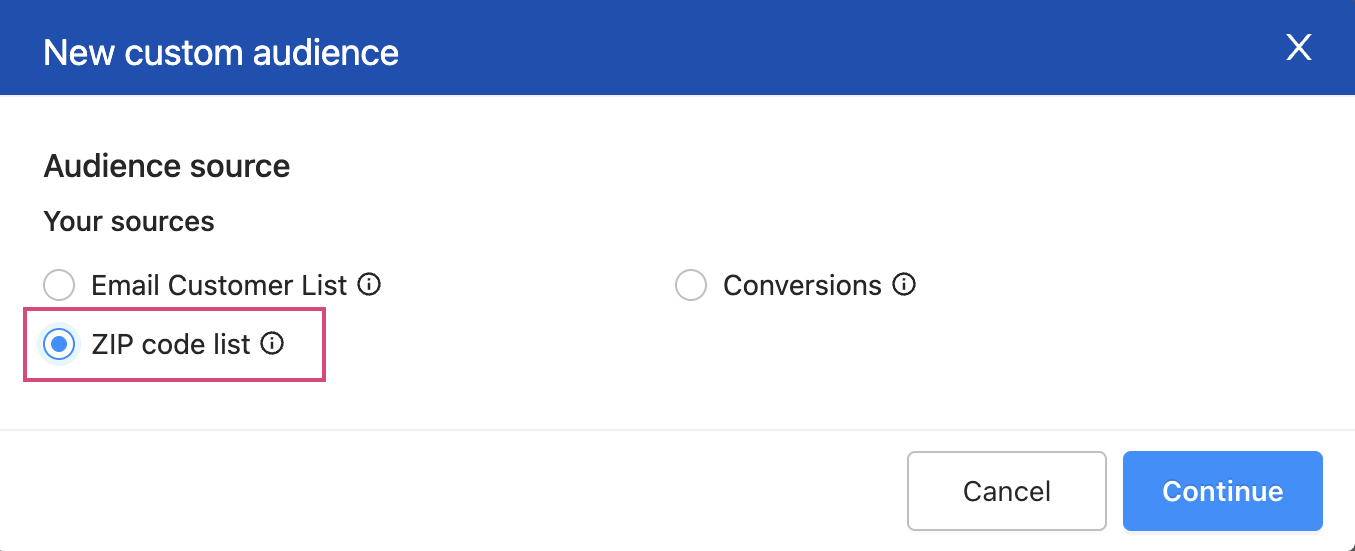
-
Enter a name for your new custom audience. Click Upload to import a CSV file from your computer.
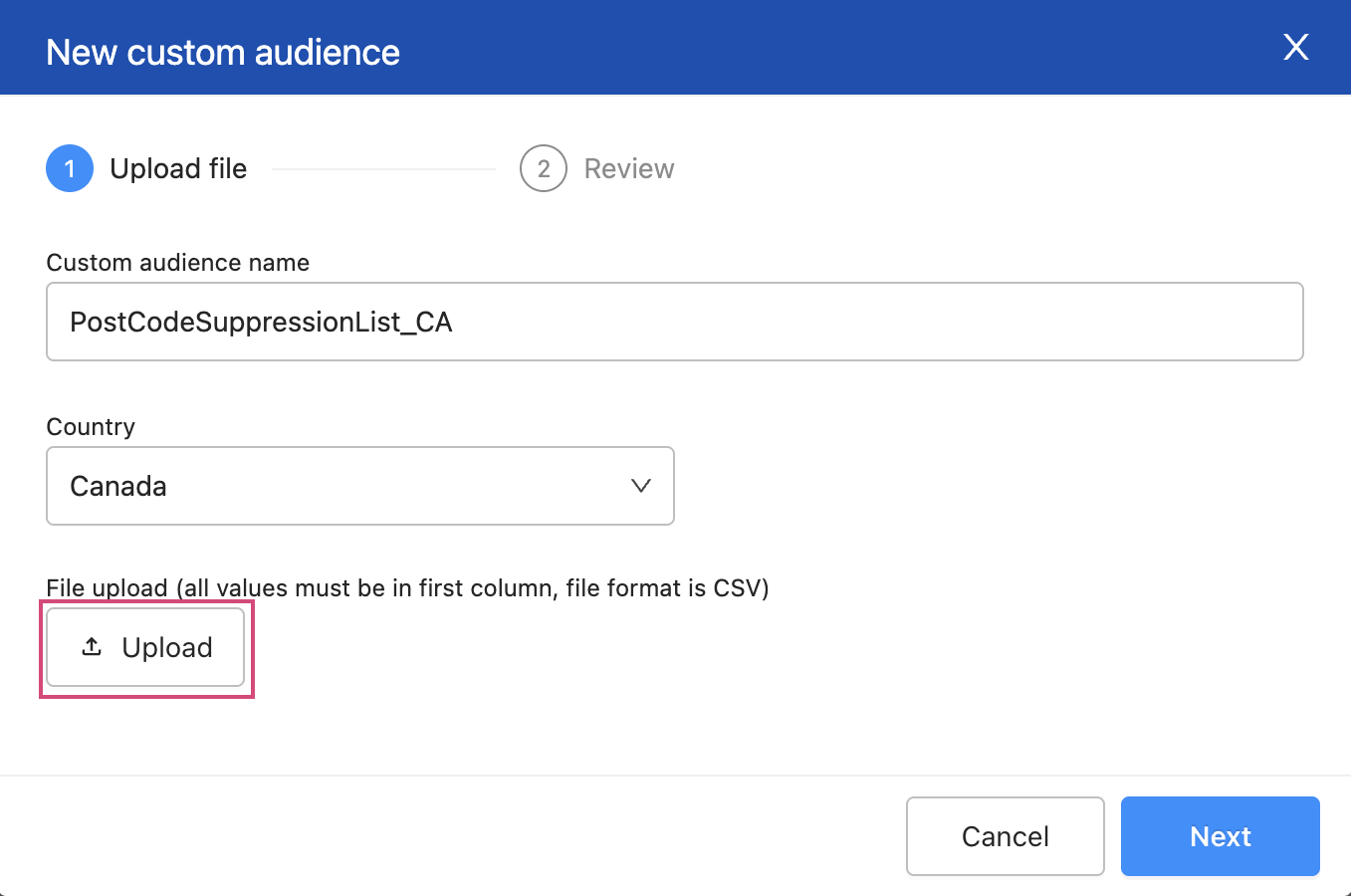
-
Once you have successfully uploaded your file, click Next.
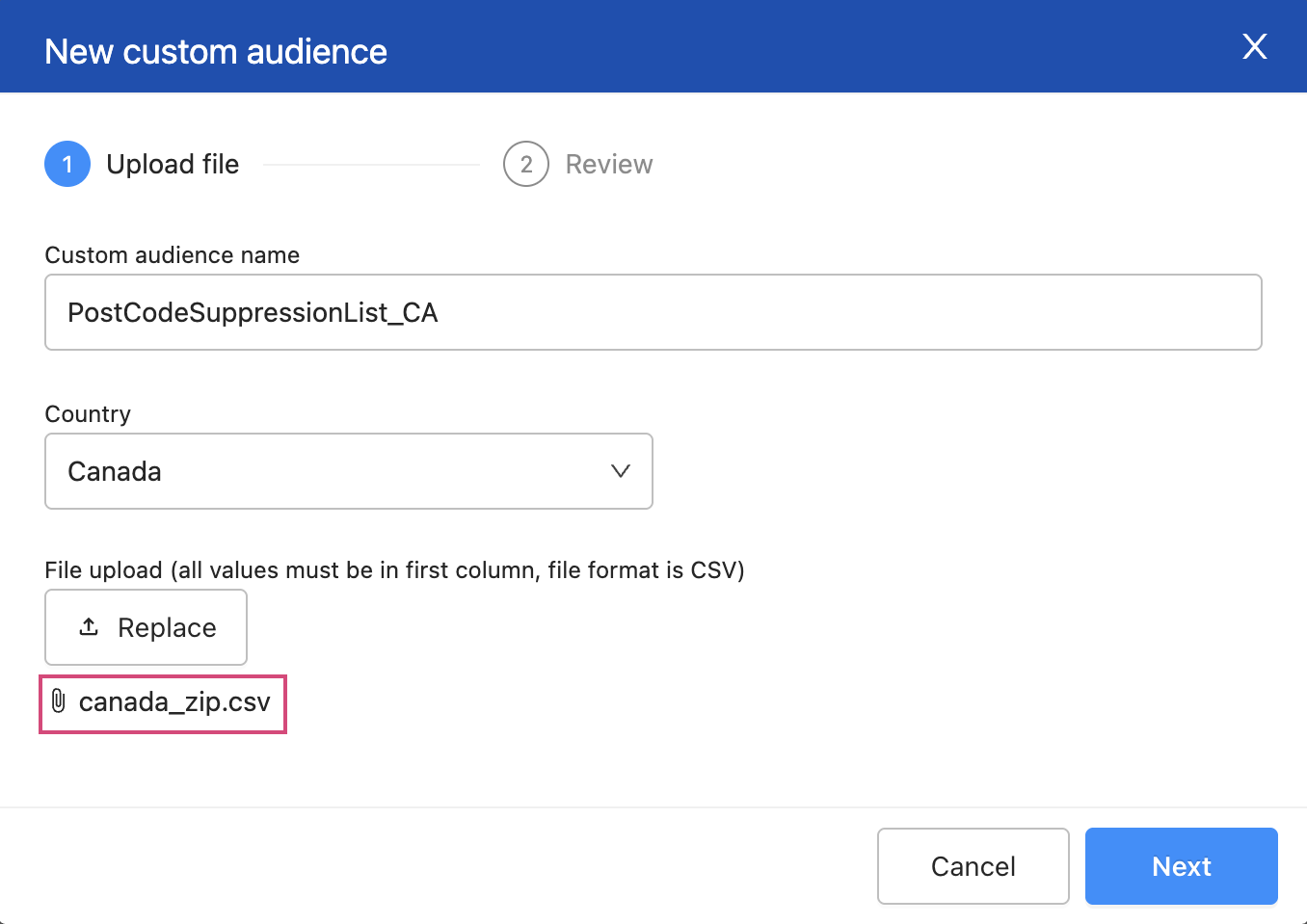
-
Review your upload and click Save.
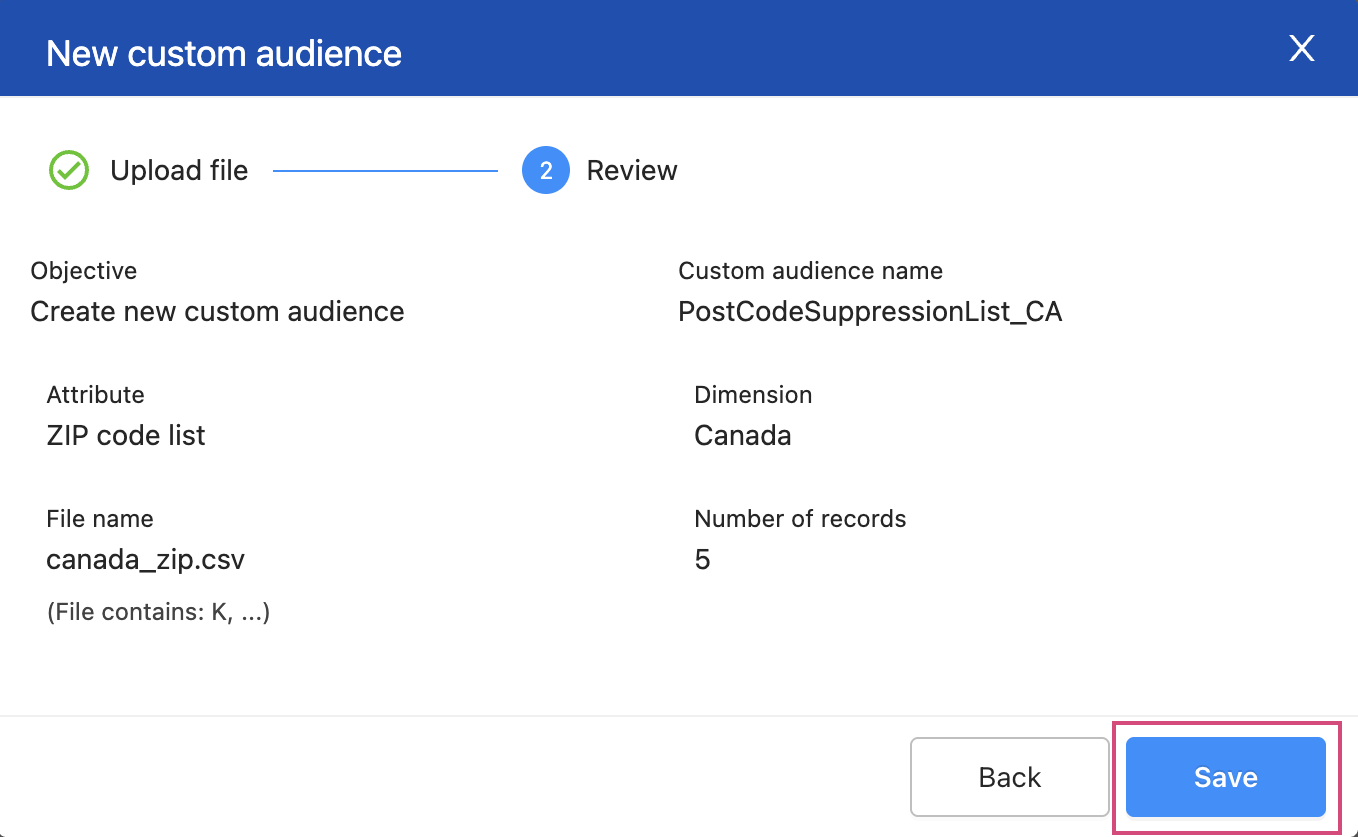
Once your import is completed, it is listed with the following information: date, file name, and contacts added or removed.
You can target or suppress these ZIP codes in your audience settings for each of your campaigns. If you edited a list you are already using in a campaign, you don't need to change your targeting options.
Adding a custom audience to your campaign
- If you selecting Include, only customers whose ZIP codes are in the selected custom audience are eligible to see an offer.
- If you selecting Exclude, customers with listed ZIP codes are not eligible to see an offer.
-
From the left navigation, click Campaigns.
-
Choose the campaign that you want to apply your customer audience to.
-
Click Add Audience in the top right corner.
-
Name your audience and enter other relevant demographic targeting details.
-
Under Location targeting, select Custom ZIP code list, then Select or upload list.
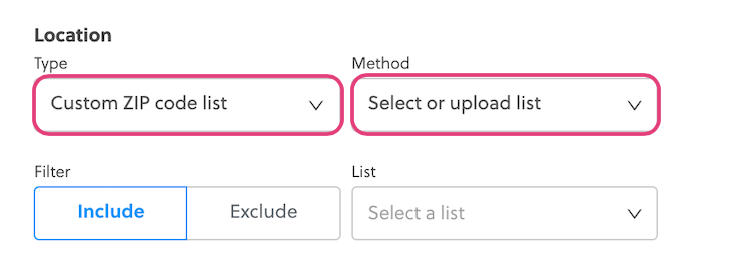
-
Select the ZIP code list you want to target or exclude (Note: Only ZIP code lists relevant to your audience country are displayed).
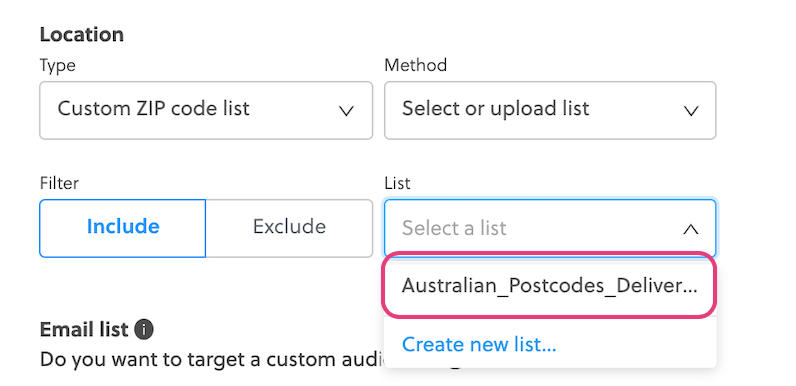
-
Continue the configuration as you would any other audience.
Import via file transfer
Establishing a connection from a host computer (e.g., your laptop) to a secure FTP server requires third-party client software. This tutorial suggests the popular and free client FileZilla which is available for Windows, Mac, and Linux operating systems.
- In your browser, navigate to https://filezilla-project.org/ and click Download FileZilla Client.
- Install FileZilla on your computer. If you already have FileZilla installed, ensure you are running the latest version.
- Reach out to your Rokt Account Manager to request access to the Rokt SFTP. Once you've been granted access, you should receive an email from Rokt with the subject "You've been granted access to Rokt's SFTP server."
- Download the attached file and unzip the encrypted file using the password provided in a second email "Email for password for file with instructions."
- The encrypted file you have just unzipped contains a
.pemfile which is your key file to access Rokt's SFTP folder.
The following steps are the same for Windows, Mac, and Linux operating systems and are based on the latest version of FileZilla.
- Open FileZilla and navigate to
File > Site Manager
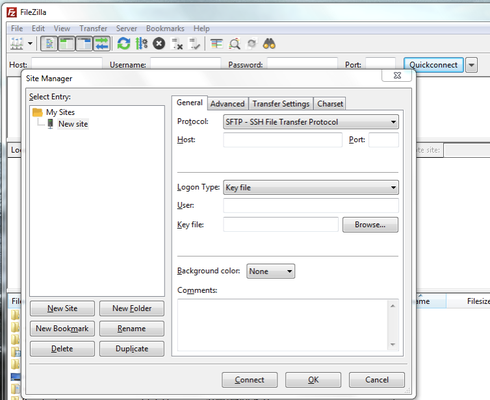
- On the left, click New Site and fill in the following:
-
Protocol: SFTP – SSH File Transfer Protocol
-
Host: ftp.rokt.com
-
Port: 22
-
Key file: Browse to your local key file (
.pem) and select it from your local drive (see image below).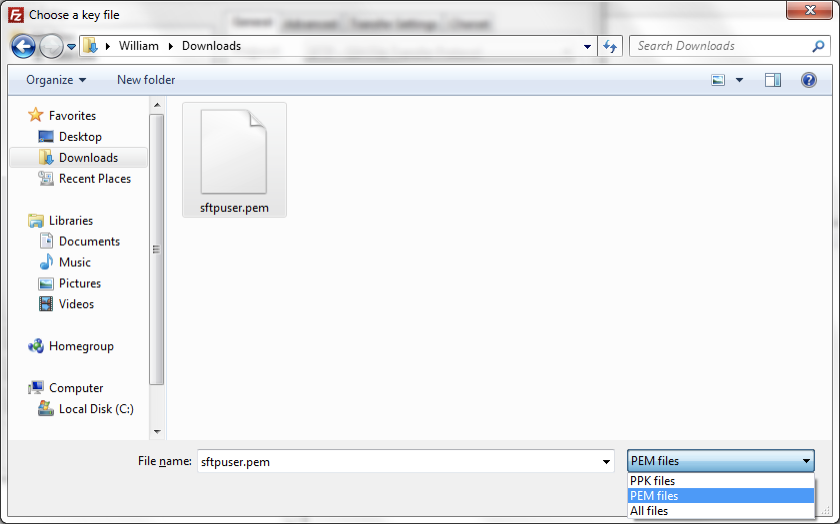
- Click Connect. You should be connected and able see your accessible folders to upload files.
Using our data management platform, Rokt can receive custom audience data at any frequency you prefer. If you’re working with Rokt as an advertiser, these lists can be used in your campaigns to either target or suppress certain customers from seeing your offers. If you’re working with Rokt as a partner these lists can be used to determine what customers see the Rokt experience on your site.
One method of delivering custom audience data to Rokt is the Rokt-hosted SFTP.
Connecting to the Rokt SFTP
Establishing a connection from a host computer (e.g., your laptop) to a secure FTP server requires third-party client software. This tutorial suggests the popular and free client FileZilla which is available for Windows, Mac, and Linux operating systems.
- In your browser, navigate to https://filezilla-project.org/ and click Download FileZilla Client.
- Install FileZilla on your computer. If you already have FileZilla installed, ensure you are running the latest version.
- Reach out to your Rokt Account Manager to request access to the Rokt SFTP. Once you've been granted access, you should receive an email from Rokt with the subject "You've been granted access to Rokt's SFTP server."
- Download the attached file and unzip the encrypted file using the password provided in a second email "Email for password for file with instructions."
- The encrypted file you have just unzipped contains a
.pemfile which is your key file to access Rokt's SFTP folder.
The following steps are the same for Windows, Mac, and Linux operating systems and are based on the latest version of FileZilla.
- Open FileZilla and navigate to
File > Site Manager

- On the left, click New Site and fill in the following:
-
Protocol: SFTP – SSH File Transfer Protocol
-
Host: ftp.rokt.com
-
Port: 22
-
Key file: Browse to your local key file (
.pem) and select it from your local drive (see image below).
- Click Connect. You should be connected and able see your accessible folders to upload files.
File path and requirements
For the majority of integrations, custom audience files should be placed within the following file path:
| File path using a default list | Purpose |
|---|---|
| /upload/custom-audience/include/AdvertiserDatabase | Add a list of customers into the default AdvertiserDatabase file associated with your account. |
| /upload/custom-audience/exclude/AdvertiserDatabase | Remove a list of customers from the default AdvertiserDatabase file associated with your account. |
If you need to upload and maintain several different custom audience lists within a single account (for example, you might have one list for customers you’d like to use in campaign targeting, and a separate list for customers you’d like to suppress from seeing your campaigns), you can create a specific custom audience list as follows:
| File path using a specific list | Purpose |
|---|---|
| /upload/custom-audience/include/MyList | Add a list of customers into a non-default custom audience list named MyList. MyList is a sub-folder you would create within the include folder as shown in the file path. |
| /upload/custom-audience/exclude/MyList | Remove a list of customers from a non-default custom audience list named MyList. MyList is a sub-folder you would create within the exclude folder as shown in the file path. |
Note: Custom audience files are automatically deleted from this folder as soon as they are processed by Rokt.
Required file formats
Files uploaded to the SFTP server must meet the following standards in order to be processed correctly in the Rokt data platform.
- File format must be
.csvor.txt - Charset UTF-8 (UTF-16 or UTF-32 with an appropriate byte-order mark)
- The list of email addresses must be formatted:
- In a single column
- Without a column head
- Email addresses can be either plain text or hashed
- If hashing email addresses, please ensure that they:
- Use SHA256 hash algorithm
- Are lowercase and trimmed (white-space removed) before hashing takes place
- Are all hashed in the same format—do not mix plain and hashed email addresses per file (emails must be all plain or all SHA256)
Any file not matching the above format will be rejected by Rokt’s system.
Temporary Files
Temporary 'staging' files can be uploaded. Any files named with a "." prefix will be treated as temporary files and not be processed until they are renamed with no "." prefix.
Import via Web SDK
Access to custom audience import via web SDK is currently via invitation only. Please contact your Rokt account manager if you are interested in this type of import.
By integrating Rokt’s web SDK snippet on any page before your confirmation page, you can re-target users who have visited that page to drive better relevance and stronger acquisition outcomes. A dynamically generated list of users is created, including any user who visited the page but didn’t convert, which can then be linked to a newly created retargeting campaign. Using this method can reduce your Cost Per Acquisition with campaigns tailored to users further down the funnel.
Before you begin
Rokt’s web SDK must be integrated directly on all pages of interest calling the ‘selectPlacements’ method with no data attributes. For multi-page applications insert the following script into the headers of the pages of interest.
<script type="module">
const target = document.head || document.body;
const script = document.createElement("script");
script.type = "text/javascript";
script.src = "https://apps.rokt.com/wsdk/integrations/launcher.js";
script.fetchPriority = "high";
script.crossOrigin = "anonymous";
script.async = true;
script.id = "rokt-launcher";
target.appendChild(script);
await new Promise((resolve) =>
window.Rokt
? resolve()
: document
.getElementById("rokt-launcher")
.addEventListener("load", () => resolve())
);
const launcher = await window.Rokt.createLauncher({
accountId: "rokt-account-id",
});
await launcher.selectPlacements({
});
</script>
For single-page applications (SPAs) follow this guide here, and notify your account manager that you'll be integrating through an SPA.
To ensure users who convert are removed from the list of users who visited your pages of interest, web SDK will need to be integrated on your confirmation page. If you're already recording conversions using web SDK, notify your account manager.
If you are not yet recording conversions on your confirmation page, the ‘captureConversion’ method on web SDK must be called, with the appropriate attributes integrated. See more on how to integrate web SDK on the conversion page here.
Once you've successfully integrated Rokt on the pages you want to generate custom audience lists from, reach out to your account manager for QA and testing.
Creating custom audience lists from web SDK
Your retargeting campaign requires two custom audiences to be created; one inclusion list for users who have visited the page of interest and one exclusion list for users who converted.
-
Log in to my.rokt.com.
-
In the left navigation bar, go to Campaigns > Custom Audiences.
-
Click New custom audience.

-
Select Website visitors as the audience source.
-
Click Continue.
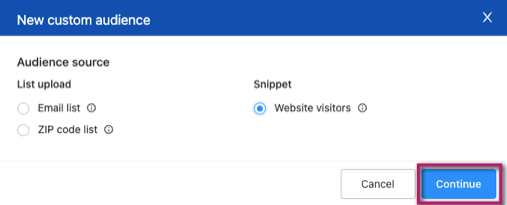
-
Enter a name for your custom audience.
-
Enter the unique portion of the URL for the page you have integrated the Rokt web SDK snippet on. For example, if you have integrated the web SDK on the product page, where the URL is www.advertiser.com/productpage/, you would enter “/productpage/”.
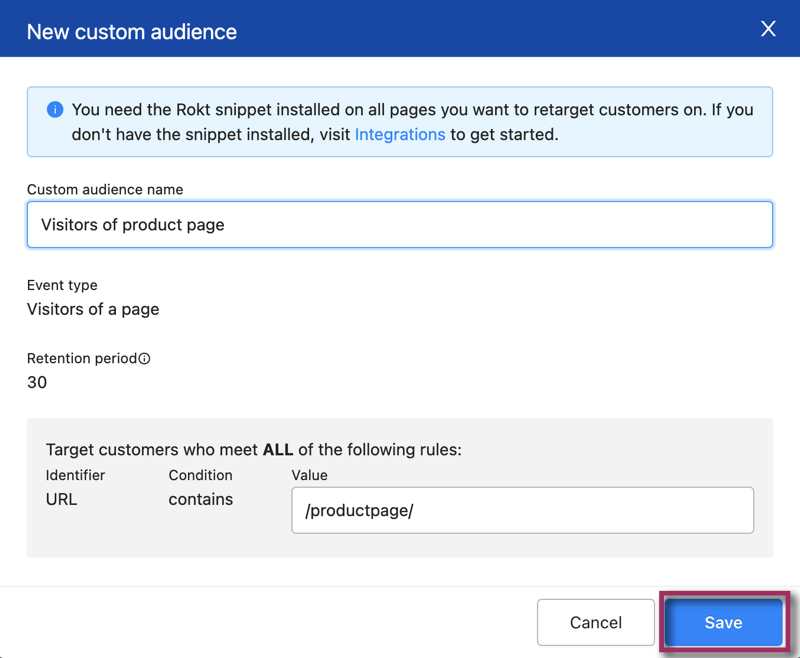
-
Click Save.
-
Repeat the process above to create a second custom audience for the conversion page. Make sure to define the URL condition as a unique portion of the conversion page URL where you have the web SDK.
-
Click Save.
noteYour new custom audience will start populating immediately, assuming the web SDK is correctly integrated on the page you have specified the audience for.
Adding custom audiences to your campaign
- Log in to my.rokt.com.
- From the left navigation, go to Campaigns.
- Select Edit for the campaign you want to apply your custom audiences to.
- Click Next to see the Audiences interface.
- Click Add.
- Name your audience and enter any other relevant demographic information.
- Click the Advanced drop-down and select Website retargeting.
- Select the custom audience for the specific page you created and set it as an inclusion list.
- Select the custom audience for the conversion page you created and set it as an exclusion list.
- Continue the configuration as you would for any other audience.
Including and excluding
- Selecting ‘Include’ results in only showing your offer to customers within the selected custom audience who visited your specific page.
- Selecting 'Exclude' will only show your offer to users outside the selected custom audience who converted.
Import via LiveRamp
LiveRamp customers can send custom audience files through LiveRamp to Rokt. These files are loaded into the Rokt data platform and are functionally identical to custom segment files delivered via other pathways such as SFTP, APIs, or UI upload.
Frequently asked questions
What is LiveRamp?
LiveRamp is a data integration platform for marketers. LiveRamp’s clients send customer lists (called custom segments) to LiveRamp where they can manage those lists. Lists can also be sent to other marketing and advertising technology providers (e.g., Facebook, Google, Salesforce DMP) for use in targeting, suppression, and measurement.
Marketers use LiveRamp for three main reasons:
- High-quality ID graphing capabilities
- Trustworthy reputation for handling sensitive client data
- Large number of supported integrations
How can I configure a delivery to Rokt?
All Rokt accounts are enabled to integrate with LiveRamp by default. You can configure your data deliveries directly from LiveRamp. To set up these deliveries, you need two pieces of information from your Rokt account manager:
- Rokt Account ID: The ID for your account in my.rokt.com.
- Rokt Account Key: A passkey that is generated by md5-hashing the value
rokt-<accountid>
You enter your Rokt Account ID and Account Key in LiveRamp to send your custom audience files to Rokt. After the delivery is first configured, allow 2–4 days for LiveRamp to send Rokt your files, and approximately 24 hours for Rokt to ingest the files into the audience system.
How can I tell if Rokt has recieved my LiveRamp data?
Once Rokt has successfully ingested your files, you can see them in my.rokt.com under Customer Data > Custom Audiences. From here, you can manage your lists and view when they were last updated.
Note that it may take 2—4 days after the initial send for your data to be available in One Platform.
What if I input the wrong account ID or account key in LiveRamp?
Rokt’s system rejects deliveries if the account key does not exactly match the expected value associated with the account ID that you input. A Rokt account manager is alerted to any error, and if necessary they will reach out to you with the correct credentials. Then you can reconfigure your delivery in LiveRamp with the right account ID and account key.
If I update my custom audience in LiveRamp, how is the data updated in Rokt's system?
When you update your list in LiveRamp, the updated list is sent to Rokt. Any new entries are added to the existing entries in the Rokt system. Entries are only appended; no entries are removed or changed. To remove or change existing entries, send a new list.
How do I configure deliveries in LiveRamp?
LiveRamp’s client-facing interface is called Connect. As a LiveRamp customer, you can use Connect to upload and manage lists, and configure deliveries to destination accounts.
- From Connect, use the text-based search tool to find the Rokt destination account.
- Select the Rokt tile.
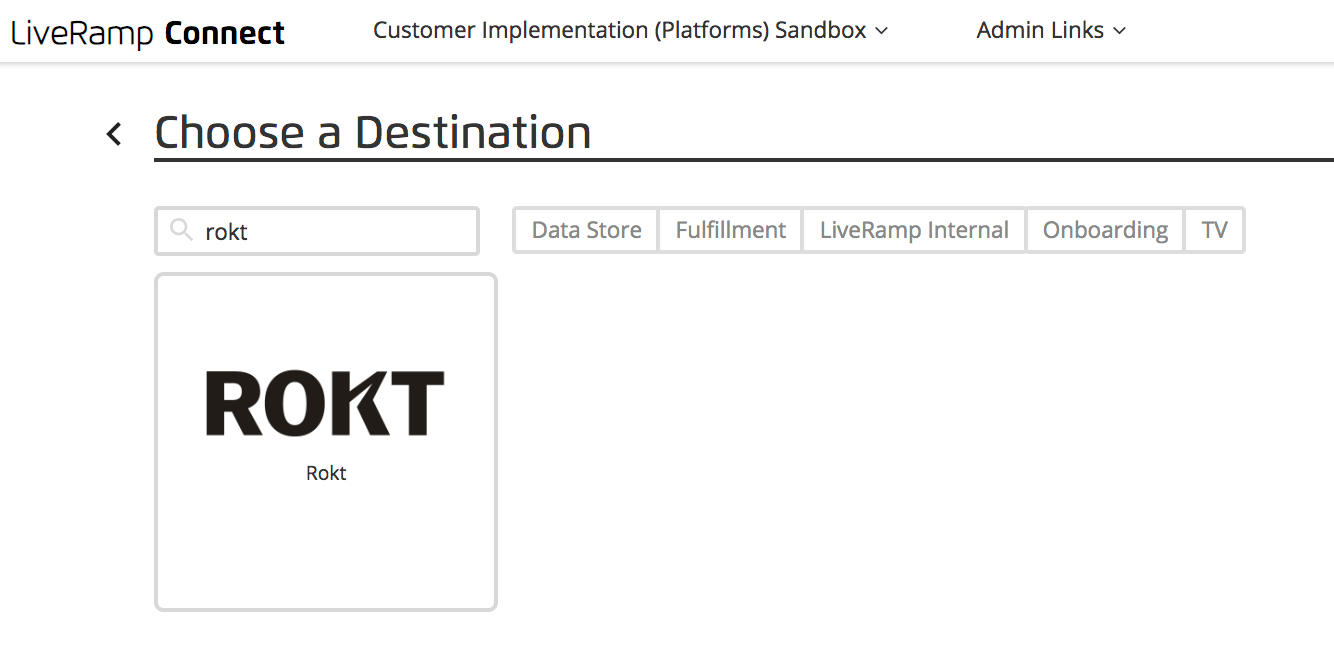
- Select the ROKT - Onboarding tile.

- Configure properties for the delivery.
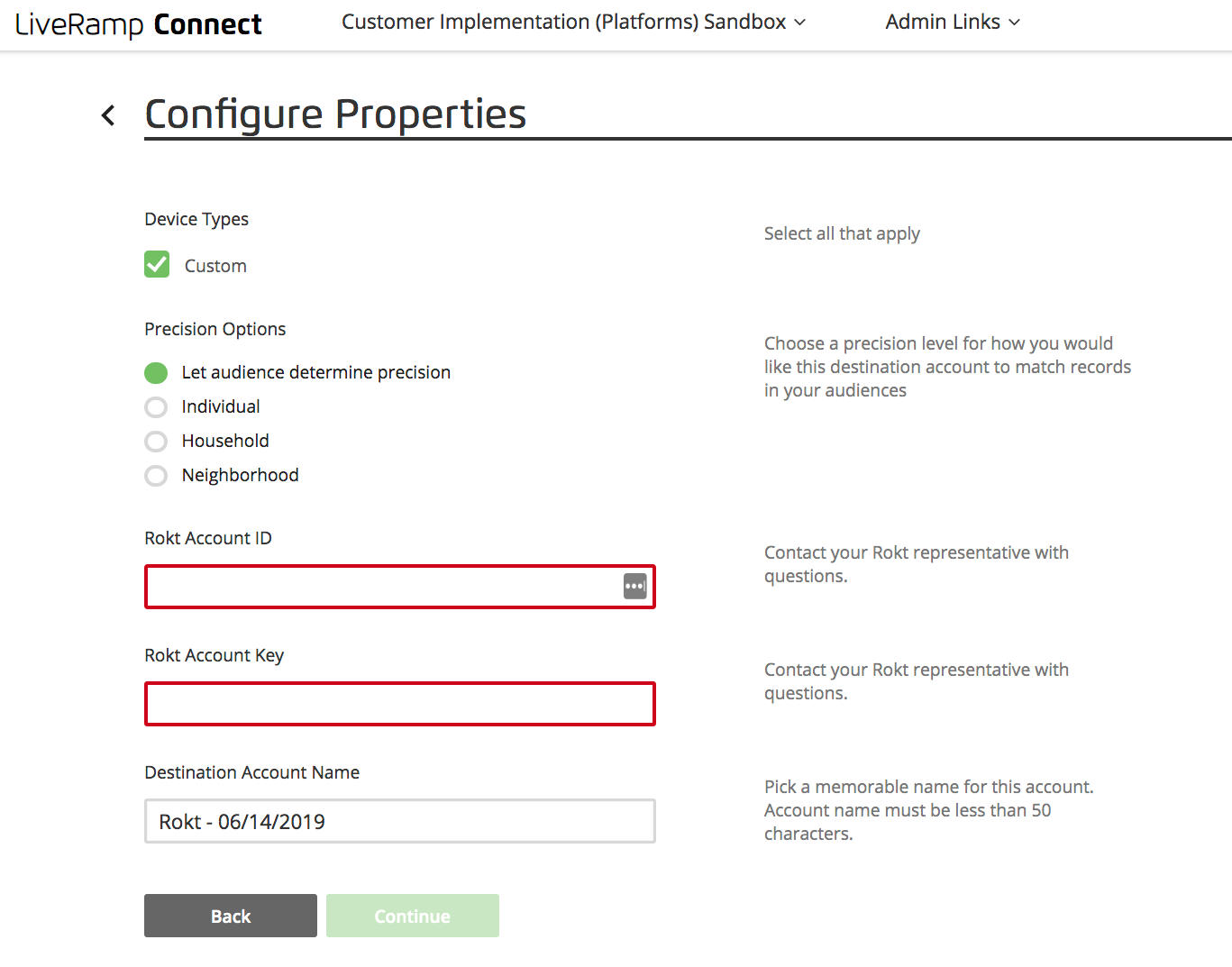
Device Types, Precision Options, and Destination Account Name are common fields in all LiveRamp destination account configurations.
- Device Types: Select Custom. As part of our integration agreement with LiveRamp, Rokt only receives custom IDs. Rokt then maps these custom IDs to hashed emails sent separately by LiveRamp for enhanced security. Rokt then uses the mapped file for targeting and suppression. Other LiveRamp partners may be integrated via cookie or mobile ID data, in which case those options would be available under Device Types.
- Precision Options: Select whichever you like. Before LiveRamp sends us your deliveries, they run your data through their ID graph to find other data points associated with entries in your list. LiveRamp then adds the associated information to your delivery. The Individual option is best for accuracy, while the Neighborhood option is best for scale.
- Rokt Account ID and Rokt Account Key: Enter the credential provided by your Rokt account manager.
- Destination Account Name: This is used to label tiles in LiveRamp. Use any name you’d like.
Visit LiveRamp’s knowledge base for additional configuration instructions.
Import via mParticle
mParticle is a third-party customer data platform that clients can use to send custom audiences to Rokt. These files will be loaded into the Rokt Data Platform and will be functionally identical to custom audience files delivered via other pathways such as secure file transfer, API, or UI upload.
For more information on this integration, please see here.
Sending custom audiences from mParticle to Rokt
All Rokt accounts are enabled by default to receive data from mParticle. You can configure your data deliveries directly from mParticle’s UI with two main steps.
- Configure Rokt as a destination for your account.
- Connect your audience(s) to the destination created in step 1.
For more information, you can read the mParticle documentation on configuring audience destinations.
Step 1: Configure Rokt as a destination in mParticle
To set up an audience delivery from mParticle to Rokt, first search for Rokt in mParticle’s directory.
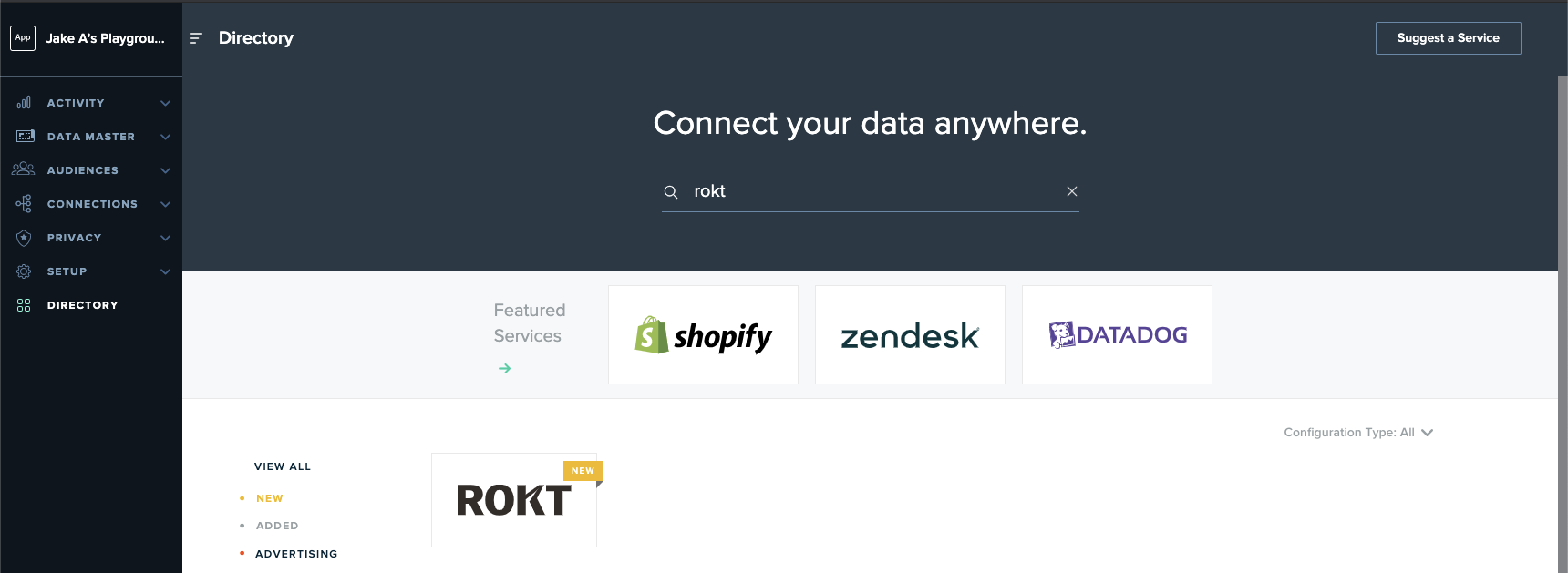
Click on the Rokt tile to start an Audience Configuration.
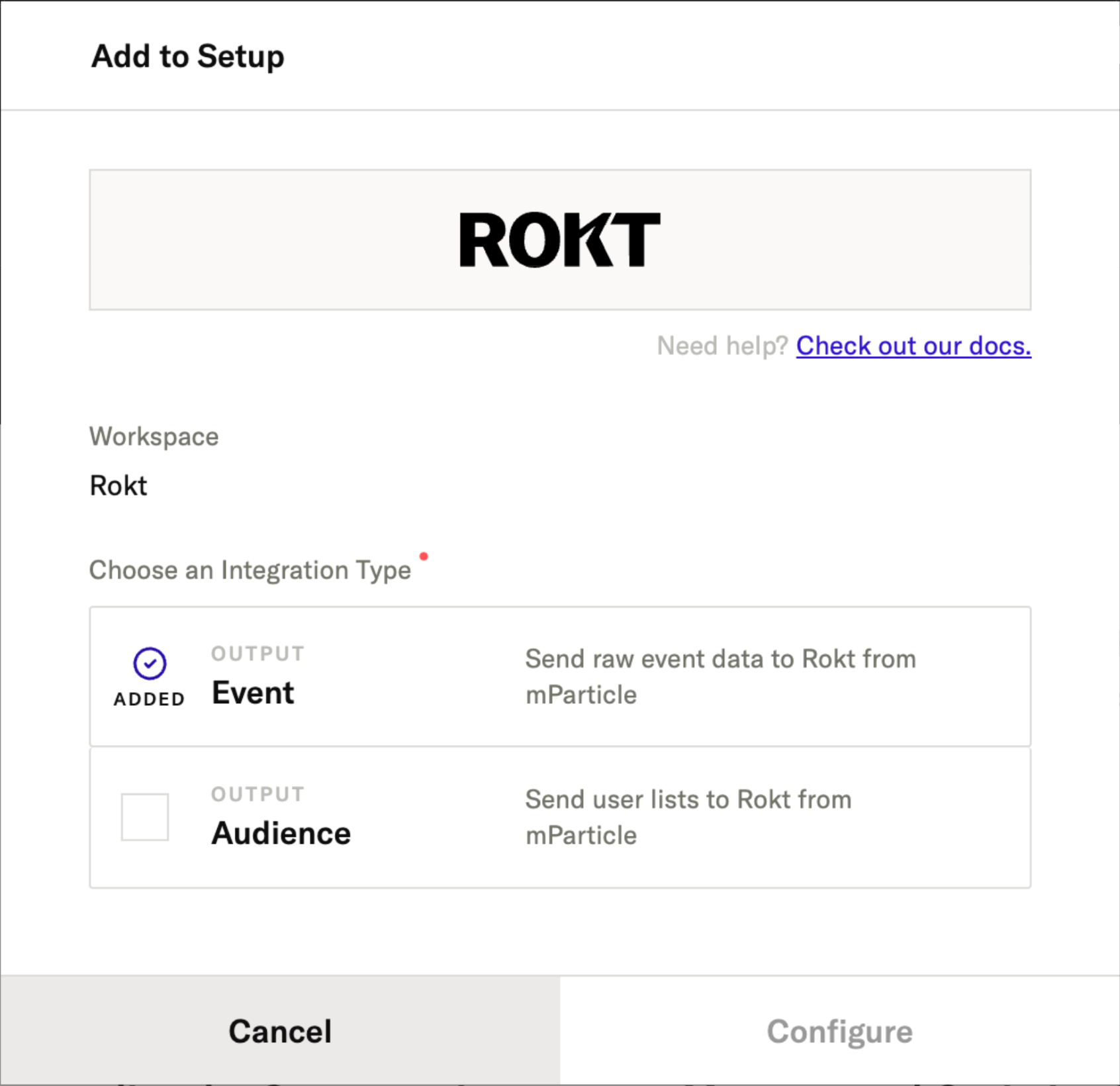
Enter the following information:
- Configuration Name: Defined by you. This is how you identify the integration in other parts of the mParticle UI.
- API Key: Ask your Rokt account manager for your unique API key.
- Rokt Account ID: Ask your Rokt account manager for your account ID.
Note: If you have multiple Rokt accounts (e.g., one account for U.S. campaigns and one account for Australian campaigns), you need to set up a separate mParticle audience configuration for each account.
Step 2: Deliver your audience to Rokt
Once Rokt has been configured as an audience destination, navigate to the Audiences tab, click into the audience(s) you would like to send to Rokt, and connect Rokt as an output.
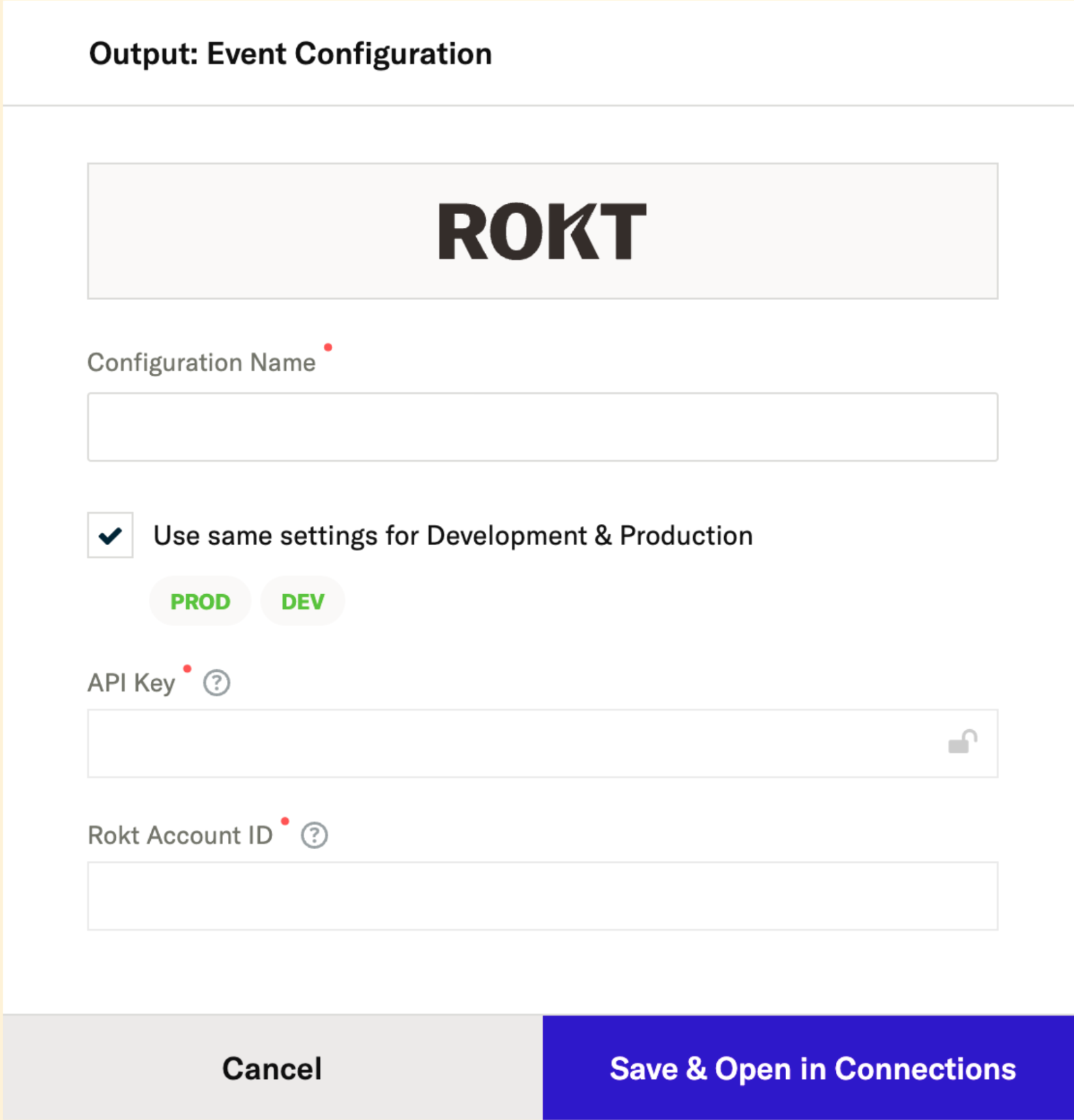
Once the integration has been set to active, mParticle will begin pushing your audience data over to Rokt. It will be visible in the Rokt UI and available for use in under 24 hours. Furthermore, Rokt continually processes membership changes to that audience. As users are added and removed in mParticle, they are also automatically added and removed in the Rokt platform.
Once the data arrives in the Rokt platform it is available as a custom audience. The audience name in the Rokt platform is the same as the audience name configured in the mParticle UI (Note: The audience name is not the same as the configuration name).
How can I tell if Rokt has received my mParticle data?
Once Rokt has successfully ingested your files, you can see them in my/rokt/com under Customer Data > Custom Audiences. From here, you can manage your lists and view when they were last updated.
Note that it may take 2—4 days after the initial send for your data to be available in One Platform.
Anything else to know about this integration?
The mParticle integration with Rokt is based on email addresses. Rokt cannot ingest mobile device IDs, cookies, or other types of identifiers. Therefore you can only send custom audiences that use an email address as an identifier. If you try to integrate an audience consisting only of cookies or device IDs, Rokt will not receive any data.
Also, while mParticle supports other types of integrations, Rokt currently only supports custom audiences. If you are interested in other types of integrations with mParticle, please contact your Rokt account manager.
Import via Segment
Segment is a third-party customer data platform that clients can use to send custom audiences to Rokt. Segment-managed audiences can be and will be functionally identical to custom audience files delivered via other pathways such as secure file transfer, API, or UI upload.
For more information on this integration please see here.